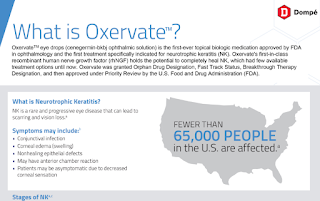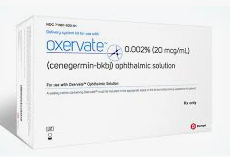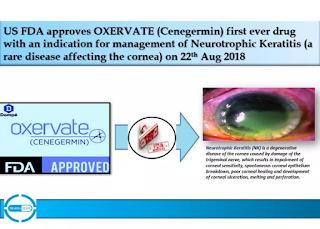Oxervate versus PRP Eye Drops: Nerve Growth Factor for Dry Eye Disease
The FDA recently approved Oxervate, a topical eye drop containing cenegermin, which is a recombinant nerve growth factor (meaning it is an artificially produced (and often purified) protein). Its safety and efficacy was studied in a total of 151 patients with neurotrophic keratitis in two, eight-week, randomized controlled multi-center, double-masked studies. While it is FDA approved, it is stil not available in the US: but PRP is…read below.
For the FDA approval, the company conducted 2 studeis.
In the first study, patients were randomized into 3different groups:
1st group received Oxervate,
2nd group received an eye drop with a different concentration of cenegermin
3rd group received an eye drop without cenegermin.
In a second study, patients were randomized into two groups.
1st group was treated with Oxervate eye drops
2nd group was treated with an eye drop without cenegermin.
All eye drops in both studies were given six times daily in the affected eye(s) for eight weeks. In the first study, only patients with the disease in 1 eye were enrolled, while in the second study, patients with the disease in both eyes were treated in both eyes (bilaterally). Across both studies, complete corneal healing in eight weeks was demonstrated in 70 %of patients treated with Oxervate compared to 28 percent of patients treated without cenegermin (the active ingredient in Oxervate).
The most common adverse reactions in patients taking Oxervate are eye pain, ocular hyperemia (enlarged blood vessels in the white of the eyes), eye inflammation and increased lacrimation (watery eyes).
This is exciting news. I will be interested to see how Oxervate compares with PRP as I think PRP will have a better effect without the side effects. In our practice PRP works in about 90% of patients without side effects. PRP has the ability to restore nerve function as noted below.
Does anyone want to help fund such a study? Please let us know.
SLC
Oxervate – What You Need to Know:
1. It is cenegermin, a recombinant nerve growth factor eye drop
2. It was recently approved by the FDA for the treatment of neurotrophic keratitis. It is not yet available in the United States.
3. Will be available likely late 2018, 2019
4. The manufacturer, Dompe Pharmaceuticals, is based in Italy and obtain orphan drug status for this rare eye condition that can result in chronic debilitating eye pain, corneal surface abnormalities and even corneal ulcers.
5. Use of Oxervate in patients with neurotrophic keratitis resulted in complete corneal healing in 70% when the drop was used 6x times daily while only 28% of patients receiving placebo experienced the same level of healing.
6. Nerve growth factor is produced normally in healthy eyes that help sustain and protect nerve cells which helps promote health and homeostasis on the ocular surface.
7. Dr. Cremers thinks that excessive electronic screen time tips many patients over the edge where other factors, like previous LASIK, Accutane use, allergies, rosacea, create an environment where normal nerve growth factor cannot do it’s job of protecting the ocular surface and prevent eye pain.
8. PRP is known to heal inflammation and heal nerve damage (see below. PRP eye drops is known to reduce the pain of dry eye in patients and to assist in the healing of damaged ocular surfaces with Meibomian gland dysfunction, dry eye syndromes, chemical burns, and corneal ulcers.
9. PRP has more than 20 identified epithelial, endothelial, and nerve growth factors along with an assortment of variously important interleukins, fibroblast growth factors, and other growth factors
10. Pain without Stain: Nerve regenerating growth factors are very important in situations where corneal nerves have become hypersensitive from chronic inflammation and result in extremely painful ocular sensations even when the eyes themselves appear relatively healthy.
SLC
More information below and references:
| Clinical data | |
|---|---|
| Trade names | Oxervate, Sentinel |
| Synonyms | Recombinant human nerve growth factor; rhNGF; human beta-nerve growth factor (beta-NGF)-(1-118) peptide (non-covalent dimer) produced in Escherichia coli[1] |
| Routes of administration |
Eye drops |
| Chemical and physical data | |
| Formula | C583H908N166O173S8 |
| Molar mass | 13266.94 g/mol |
Cenegermin (planned brand names Oxervate, Sentinel), also known as recombinant human nerve growth factor (rhNGF), is a recombinant form of human nerve growth factor(NGF). It was approved in the European Union as an eye drop formulation for the treatment of moderate or severe neurotrophic keratitis in adults on 6 July 2017.[2][3][1] As a recombinant form of NGF, cenegermin is a peripherally selective agonist of the TrkA and LNGFR (p75NTR) which must be administered parenterally.[3] In addition to neurotrophic keratitis, cenegermin is also under development for the treatment of dry eyes, retinitis pigmentosa, and glaucoma.[3] It was developed by Anabasis Pharma, Dompé Farmaceutici, and Ospedale San Raffaele.[3]
Platelet-rich plasma (PRP), which contains growth factors that positively influence neural cell survival, have the potential to promote peripheral nerve regeneration. (Ref 1,2,3)
Summary of potential cytokines and growth factors from α-granules within platelet-rich plasma
| Growth factors | Function | Mechanisms | References |
|---|---|---|---|
| Transforming growth factor-β (TGF-β) | Stimulates endothelial chemotaxis and angiogenesis Regulates mitogenic effects of other growth factors (nerve growth factor, brain derived neurotrophic factor, etc) Induces undifferentiated mesenchymal cell proliferation Stimulates neurite outgrowth and regulates differentiation of SCs Inhibits macrophage and lymphocyte proliferation. |
Secrets into the local nerves by damaged neurons, invading macrophages and degenerated schwann cells (SCs) during Wallerian degeneration Activates SCs and recruit macrophages to the injury site of distal nerve stumps |
Unsicker and Strelau41 Gordon et al.42 Sulaiman and Dreesen43 |
| Platelet-derived growth factor (PDGF) | Stimulates trophic activity on neurons Induces SCs proliferation, differentiation and myelin formation Mitogenetic for mesenchymal cells and osteoblasts. Involved in the wound healing of hard and soft tissues and for central nervous system development Stimulates hyaluronan and glycosaminoglycans (components of the extracellular matrix) |
Acts on the factor tyrosine kinases (RTKs) and the downstream PI3K and mitogen-activated protein (MAP) kinase signaling pathways Stimulates chemotaxis of neutrophils and macrophages to the injured sites and participates in tissue re-epithelialization and/or angiogenesis |
Graham et al.44 Yamazaki et al.45 Burnouf et al.46 Hellman et al.47 |
| Vascular endothelial growth factor (VEGF) | Enhances angiogenesis and vessel permeability Regulates cell proliferation and mediates antiapoptotic effect Stimulates mitogenesis for endothelial cells Promotes blood vessel growth, neurogenesis and neuroprotection |
Induces injury-related angiogenesis by connecting to endothelial transmembrane receptors identified as fms-like tyrosine kinase (FLT-1), fetal liver tyrosine kinase receptor (FLK-1) and neurophilin-1 | Mackenzie and Ruhrberg48 Hermann and Zechariah49 |
| Insulin-like growth factor-1 (IGF-1) | Initiates the formation of bud growth Supports the forward extension of the nerve fibers Suppresses apoptosis in motor, sensory and sympathetic neurons Stimulates protein synthesis |
Via the PI3K pathway, induces SCs to synthesize of two fatty acids that initiates the process of myelination Secreted in the vicinity of the injured nerve sites and its receptors are mainly expressed on axon, nerve terminals, SCs and motor neuron cell bodies, promoting early recovery of sensation |
Liang et al.50 Nagata et al.51 |
| Basic fibroblast growth factor (bFGF) | Contributes to embryonic development, angiogenesis and wound healing Facilitates neuroprotection and SCs regeneration |
After peripheral nerve injury, bFGF and its high-affinity tyrosine kinase receptor FGFR-3 are upregulated in sensory neurons and at the lesion site of the nerve, inducing angiogenesis and accelerates wound closure | Grothe and N |
References:
- Dagum AB. Peripheral nerve regeneration, repair, and grafting. J Hand Ther 1998; 11 (2): 111–117.[PubMed]
- Qin J, Wang L, Sun Y et al. Concentrated growth factor increases Schwann cell proliferation and neurotrophic factor secretion and promotes functional nerve recovery in vivo. Int J Mol Med 2016; 37 (2): 493–500. [PubMed]
- Int J Oral Sci. 2017 Mar; 9(1): 1–9.
-
Published online 2017 Mar 10. doi: [10.1038/ijos.2017.1]PMCID: PMC5379164PMID: 28282030
Platelet-rich plasma for regeneration of neural feedback pathways around dental implants: a concise review and outlook on future possibilities




